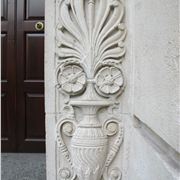Category: Good
What?
Arkwright House
When and who?
1927-8 designed by the Harry S Fairhurst practice
More about them please?
In the first half of the twentieth century if you stood around in an empty lot for long enough it'd be likely that a Harry S Fairhurst building would form around you. His lot were prolific: Bridgewater House, Ship Canal House, Lancaster House, Lee House, your house, my house, his house, her house....

I get the message. Tell me about Arkwright House?
It's right on the ball for late 1920s fashion. A pared down Classical look, a brutal Classical look. Pilasters, attached columns, fancy work around the doors of urns, torches, tridents and made from Portland Stone. Always Portland stone. A white sedimentary rock full of fossilised shells, made from millions of years of compressed shells. Very white, the white man's burden.
What can you mean?
The reference is Imperial Rome. The time is Imperial Britain. But a very different Imperial Britain from that of before WW1. This is Imperial Britain on the way out. The textile warehouses around Whitworth Street and Oxford Road were built before the country had a million casualties in the 1914-18 war, before the Wall Street Crash, before the General Strike, before the rise of Fascism and Bolshevism. They were looking ahead in a big, bombastic, optimistic Baroque style.
Here, despite the strident Classical building, I sense doubt. Maybe it's me imbuing the building with the atmosphere of the troubled twenties, but to me this is British architecture trying to convince itself and its clients that the nation's place in the world as a top three or four country was assured forever.
No, not true. It's a wonderful urban building, a good city centre structure. But I feel it's trying too hard to be something Britain couldn't be anymore. It's also tainted with what would come in Germany. This style of Classicism is what Hitler preferred. And his architect Albert Speer. Look at that sinister eagle. Very Third Reich although the intended reference here is, as stated, to Imperial Rome and thus Imperial Britain. Still it gives me the shivers - although to be fair the Fairhurst practice of architects couldn't have known about National Socialism, they were following fashion. There's another reference on the inside of the building which is less sinister.
Fire away
The stairwell is a beautiful tile and mosaic affair. This gives a nod to the gold and glitter of the Tutankhamun tomb discovery in 1922 by Howard Carter. It's lovely. But back to things that alarm me.
A nod to Tut?
Go on
The building is very London. There are scores upon scores of these buildings in the capital. The nineteenth century was the century were the provinces, particularly the industrial North and the industrial Midlands, had asserted themselves, stolen the limelight. Manchester and Birmingham had led politics nationally and throughout the Empire. We were acknowledged powerhouses, centres of intellectual dynamism, especially with Manchester's Free Trade movement. After WW1 that collapsed and the old medieval hyper-importance of the capital returned. Manchester and Birmingham faded. To me this building represents that decline and that continuing imbalance in British life.
Who was it built for?
It was built for the English Sewing Cotton Company but in WWII it had a different role - ironic given the comments about the Third Reich.
Which was?
It was the headquarters of the Civil Defence in the North West. Sir Warren Fisher, in the event of invasion, would have had absolute authority over 7m people from Scotland to Staffordshire. This is excellently described in Keith Warrender's marvellous book, 'Below Manchester'. I find it vaguely amusing that the War Room was more or less under Revolution Bar. War and Revolution.
 The old picture looks different somehow from the new one
The old picture looks different somehow from the new one
It does, doesn't it? That's because of the west side. None of the architectural guides mention the fact that it wasn't until after WWII that the building was completed. It was only then extended to the road, St Mary's Parsonage - balancing up the design.
You can follow Jonathan Schofield on Twitter here @JonathSchofield















